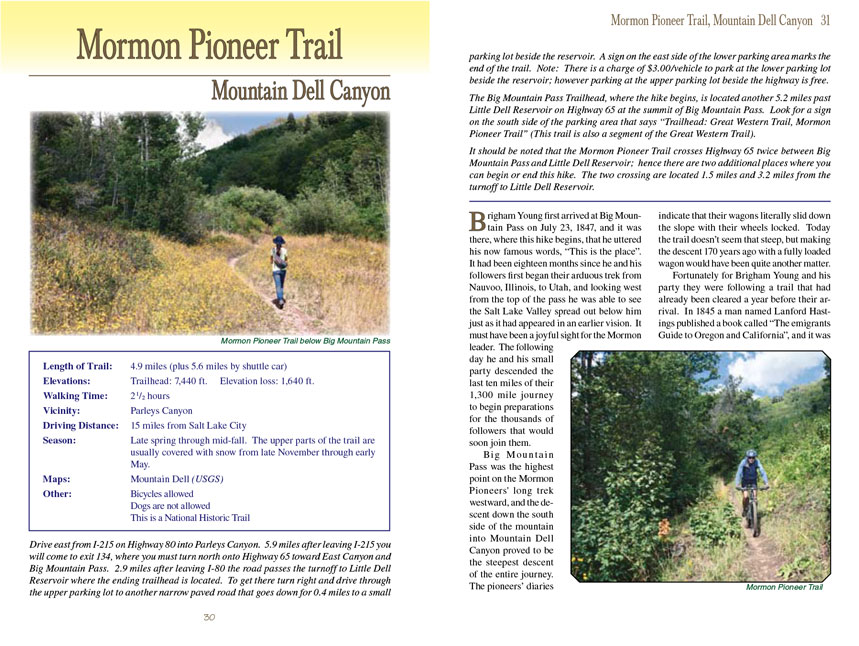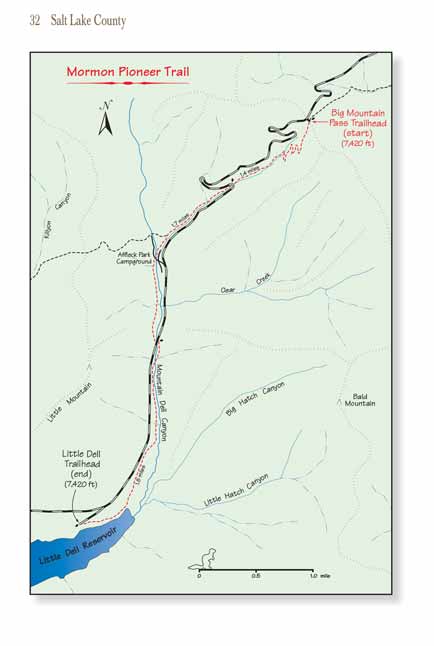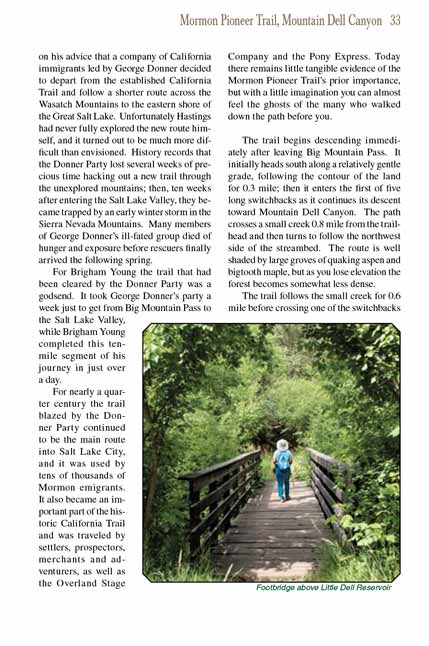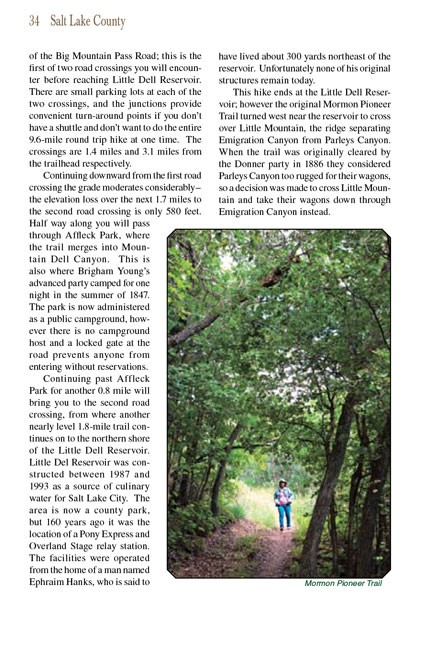Mormon Pioneer Trail
Mountain Dell Canyon
excerpted from our book
Salt Lake City's Incredible Hiking and Biking Trails
pages 30-34
|
Buy book directly from the author!
Salt Lake City's Incredible Hiking and Biking Trails
- has access info for 73 trailheads
- 73 colorful trail maps
- 325 full color photographs
- loads of hiking tips
|
regularly $19.95
now on sale for only
$9.95
click here
for book orders
|


 Brigham Young first arrived at Big Mountain Pass on July 23, 1847, and it was there, where this hike
along the Mormon Pioneer Trail begins, that he uttered his now
famous words, “This is the place”. It had been eighteen months since he and his followers first began their arduous trek from Nauvoo, Illinois, to Utah, and
looking west from the top of the pass he was able to see the Salt Lake Valley spread out below him just as it had appeared in an earlier vision. It must have
been a joyful sight for the Mormon leader. The following day he and his small party descended the last ten miles of their 1,300 mile journey to begin
preparations for the thousands of followers that would soon join them.
Brigham Young first arrived at Big Mountain Pass on July 23, 1847, and it was there, where this hike
along the Mormon Pioneer Trail begins, that he uttered his now
famous words, “This is the place”. It had been eighteen months since he and his followers first began their arduous trek from Nauvoo, Illinois, to Utah, and
looking west from the top of the pass he was able to see the Salt Lake Valley spread out below him just as it had appeared in an earlier vision. It must have
been a joyful sight for the Mormon leader. The following day he and his small party descended the last ten miles of their 1,300 mile journey to begin
preparations for the thousands of followers that would soon join them.
Big Mountain Pass was the highest point on the Mormon Pioneers' long trek westward, and the descent down the south side of the mountain into Mountain Dell Canyon
proved to be the steepest descent of the entire journey. The pioneers’ diaries indicate that their wagons literally slid down the slope with their wheels locked.
Today this section of the Mormon Pioneer Trail doesn’t seem that steep, but making the descent 170 years ago with a fully loaded wagon would have been quite another matter.
Fortunately for Brigham Young and his party they were following a trail that had already been cleared a year before their arrival. In 1845 a man named Lanford
Hastings published a book called “The emigrants Guide to Oregon and California”, and it was on his advice that a company of California immigrants led by George
Donner decided to depart from the established California Trail and follow a shorter route across the Wasatch Mountains to the eastern shore of the Great Salt
Lake. Unfortunately Hastings had never fully explored the new route himself, and it turned out to be much more difficult than envisioned. History records
that the Donner Party lost several weeks of precious time hacking out a new trail through the unexplored mountains; then, ten weeks after entering the Salt
Lake Valley, they became trapped by an early winter storm in the Sierra Nevada Mountains. Many members of George Donner’s ill-fated group died of hunger
and exposure before rescuers finally arrived the following spring.
For Brigham Young the Mormon Pioneer Trail that had been cleared by the Donner Party was a godsend. It took George Donner’s party a week just to get from Big Mountain Pass to
the Salt Lake Valley, while Brigham Young completed this ten-mile segment of his journey in just over a day.
For nearly a quarter century the Mormon
Pioneer Trail blazed by the Donner Party continued to be the main route into Salt Lake City, and it was used by tens of thousands of
Mormon emigrants. It also became an important part of the historic California Trail and was traveled by settlers, prospectors, merchants and adventurers, as
well as the Overland Stage Company and the Pony Express. Today there remains little tangible evidence of the Mormon Pioneer Trail’s prior importance, but with
a little imagination you can almost feel the ghosts of the many who walked down the path before you.
 The Mormon Pioneer Trail begins descending immediately after leaving Big Mountain Pass. It initially heads south along a relatively gentle grade,
following the contour of the land for 0.3 mile; then it enters the first of five long switchbacks as it continues its descent toward Mountain Dell Canyon. The
path crosses a small creek 0.8 mile from the trailhead and then turns to follow the northwest side of the streambed. The route is well shaded by large groves
of quaking aspen and bigtooth maple, but as you lose elevation the forest becomes somewhat less dense.
The Mormon Pioneer Trail begins descending immediately after leaving Big Mountain Pass. It initially heads south along a relatively gentle grade,
following the contour of the land for 0.3 mile; then it enters the first of five long switchbacks as it continues its descent toward Mountain Dell Canyon. The
path crosses a small creek 0.8 mile from the trailhead and then turns to follow the northwest side of the streambed. The route is well shaded by large groves
of quaking aspen and bigtooth maple, but as you lose elevation the forest becomes somewhat less dense.
The Mormon Pioneer Trail follows the small creek for 0.6 mile before crossing one of the switchbacks of the Big Mountain Pass Road; this is the first of two road crossings you
will encounter before reaching Little Dell Reservoir. There are small parking lots at each of the two crossings, and the junctions provide convenient turn-around
points if you don’t have a shuttle and don’t want to do the entire 9.6-mile round trip hike at one time. The crossings are 1.4 miles and 3.1 miles from the
trailhead respectively.
Continuing downward from the first road crossing the grade moderates considerably-the elevation loss over the next 1.7 miles to the second road crossing is only
580 feet. Half way along you will pass through Affleck Park, where the Mormon
Pioneer Trail merges into Mountain Dell Canyon. This is also where Brigham Young’s advanced party
camped for one night in the summer of 1847. The park is now administered as a public campground, however there is no campground host and a locked gate at the
road prevents anyone from entering without reservations.
Continuing past Affleck Park on the Mormon
Pioneer Trail for another 0.8 mile will bring you to the second road crossing, from where another nearly level 1.8-mile trail continues on to the
northern shore of the Little Dell Reservoir. Little Del Reservoir was constructed between 1987 and 1993 as a source of culinary water for Salt Lake City. The
area is now a county park, but 160 years ago it was the location of a Pony Express and Overland Stage relay station. The facilities were operated from the home
of a man named Ephraim Hanks, who is said to have lived about 300 yards northeast of the reservoir. Unfortunately none of his original structures remain today.
This hike ends at the Little Dell Reservoir; however the original Mormon Pioneer Trail turned west near the reservoir to cross over Little Mountain, the ridge
separating Emigration Canyon from Parleys Canyon. When the trail was originally cleared by the Donner party in 1886 they considered Parleys Canyon too rugged
for their wagons, so a decision was made to cross Little Mountain and take their wagons down through Emigration Canyon instead.
Note to web developers: You may copy this material onto your site, but in return please include a link to my home page
www.utahtrails.com. Thank you, David Day (utahdavidday at gmail.com)
Click here to see more
trails near Salt Lake City
© Rincon Publishing Company, all rights reserved
|


 Brigham Young first arrived at Big Mountain Pass on July 23, 1847, and it was there, where this hike
along the Mormon Pioneer Trail begins, that he uttered his now
famous words, “This is the place”. It had been eighteen months since he and his followers first began their arduous trek from Nauvoo, Illinois, to Utah, and
looking west from the top of the pass he was able to see the Salt Lake Valley spread out below him just as it had appeared in an earlier vision. It must have
been a joyful sight for the Mormon leader. The following day he and his small party descended the last ten miles of their 1,300 mile journey to begin
preparations for the thousands of followers that would soon join them.
Brigham Young first arrived at Big Mountain Pass on July 23, 1847, and it was there, where this hike
along the Mormon Pioneer Trail begins, that he uttered his now
famous words, “This is the place”. It had been eighteen months since he and his followers first began their arduous trek from Nauvoo, Illinois, to Utah, and
looking west from the top of the pass he was able to see the Salt Lake Valley spread out below him just as it had appeared in an earlier vision. It must have
been a joyful sight for the Mormon leader. The following day he and his small party descended the last ten miles of their 1,300 mile journey to begin
preparations for the thousands of followers that would soon join them.
 The Mormon Pioneer Trail begins descending immediately after leaving Big Mountain Pass. It initially heads south along a relatively gentle grade,
following the contour of the land for 0.3 mile; then it enters the first of five long switchbacks as it continues its descent toward Mountain Dell Canyon. The
path crosses a small creek 0.8 mile from the trailhead and then turns to follow the northwest side of the streambed. The route is well shaded by large groves
of quaking aspen and bigtooth maple, but as you lose elevation the forest becomes somewhat less dense.
The Mormon Pioneer Trail begins descending immediately after leaving Big Mountain Pass. It initially heads south along a relatively gentle grade,
following the contour of the land for 0.3 mile; then it enters the first of five long switchbacks as it continues its descent toward Mountain Dell Canyon. The
path crosses a small creek 0.8 mile from the trailhead and then turns to follow the northwest side of the streambed. The route is well shaded by large groves
of quaking aspen and bigtooth maple, but as you lose elevation the forest becomes somewhat less dense.